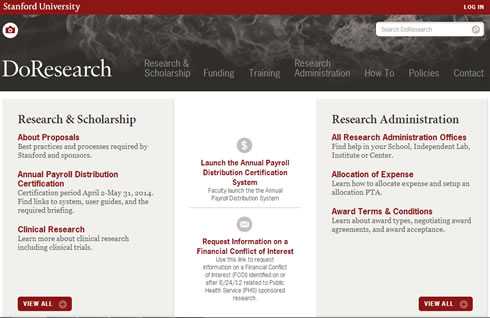New tech tools, IT functionality are helping universities better leverage research for funding, marketing, and relevance
 There’s not a person in the higher education world who would tell you that research—the production of, dissemination of, and funding of—isn’t mission-critical for most colleges and universities. And now, thanks to innovative IT practices, admin-created projects and cutting-edge technology tools, today’s research-intensive universities are getting a much-needed 21st Century makeover.
There’s not a person in the higher education world who would tell you that research—the production of, dissemination of, and funding of—isn’t mission-critical for most colleges and universities. And now, thanks to innovative IT practices, admin-created projects and cutting-edge technology tools, today’s research-intensive universities are getting a much-needed 21st Century makeover.
And one of the country’s most revered universities is leading the way with its current revamp of what it considers a cornerstone of the institution.
“The nature of sponsored research requires faculty and staff to wade through mountains of procedural and technical information to apply for and administer grant-funded research activities,” explained Patti McCabe, the director of training and communications in the office of the vice provost and dean of research.. “As the National Science Board’s March 2014 report states, ‘During the last two decades, surveys, articles, and reports have indicated that increased administrative and compliance requirements associated with federally-funded research are consuming a significant proportion of the time that our Nation’s scientists, engineers, and educators dedicate to this research.’”
“We needed to make this process easier with our website,” she continued, “easier to understand, easier to navigate, easier to meet compliance requirements. Good design, at its best, would be part of our solution.”
(Next page: Taking Stanford’s research to the next level)
In seeking to create a website to improve and facilitate the work of research admin for faculty and staff at Stanford, McCabe explained the need to leverage the endorsement of the Office of the Dean of Research—the primary stakeholder for the website and the senior office for research policy.
“A small change, [but] spelling out the word ‘Research’ accomplished all the objectives in a simple, easy, natural way,” she said. “The name of the site, DoResearch, established a visual identity that is as compelling as the site is functional—and that builds upon Stanford’s research legacy. The name and the site itself became a directive and a rallying-point to actively engage in research at Stanford.”
According to McCabe, the website has two high priority functions:
- Provide accurate and up-to-date reference materials in one place.
- Create a learning environment for faculty and staff to augment classroom training.
And lower priority functions:
- Publicity and outreach (news & events).
- Provide funding opportunities.
The DoResearch team also followed a set of 8 guidelines:
1. We are interested in web systems, not just websites.
2. Information architects should take into account the business logic of research administration, and the developer should expose opportunities to realize the full potential of the CMS.
4. Follow user-centered design.
5. Strive for concinnity: The skillful and harmonious arrangement or fitting together of the different parts of something.
6. Employ visually stunning graphic design, imagery, typography and whitespace in service to the overall goal of the project.
7. Since the website is an authoritative reference, we must have precise information design.
8. Overall design must follow instructional design since the website is a learning environment–always ask if design serves the purpose.
Stanford used Four Kitchens—a web design and development company—to help them in their research website revamp, as well as to add some effective features as part of the research portal.
One feature that McCabe described as a “magical functionality” is the ‘token.’
“Much like a rubber stamp that makes sure your address is the same each time it is used, the token can be inserted into any page and the same content will always show up the same,” said a rep for the company. “An improvement on the stamp is that if an administrator wants to update the address, it only has to be done once and it will update everywhere.
18 months out, McCabe says the site is going strong and is “incredibly easy to maintain thanks to the cool features Four Kitchens developed.”
“Completion of the long-awaited DoResearch website filled a huge need in the Stanford Research Administration community,” said Robin Maslin, manager of Environmental Earth System Science. “It is an excellent reference tool that is inviting to use, easy to browse and locate vital rates and compliance guidance, and can be counted on to have the most up-to-date information that is so critical in supporting our jobs as stewards of federal and private research funds.”
Of course, McCabe emphasized that team collaboration was a critical component to success of the project, adding that “I feel like a gardener in my own garden, constantly pruning, trimming and creating. Surrounded by a great team, the possibilities are endless.”
(Next page: A collaboration tool for university researchers)
Stanford is not the only major research university looking to technology to enhance the quality and reach of their research, as Michigan State University’s (MSU) recently decided to implement a messaging server to empower collaborative research and community outreach projects.
“As a university grows, it must deal with wider communication gaps among staff, especially in a research setting,” said a rep for the University. “MSU recently sought out a solution to help several research teams collaborate…called IceWarp,” a global messaging solutions provider.
Learn more about IceWarp:
[field name=iframe2]
The University’s Department of Entomology first sought out an on-premise eMail server that would allow it to rapidly create mailing lists and listservs, all while being reliable and easy to manage.
“We needed to include outside researchers not connected with the university,” explained Amos Ziegler, Director of the Applied Spatial Ecology and Technical Services (ASETS) Laboratory in the Department of Entomology. “Effective collaboration required the capability to rapidly create mailing lists and listservs.” The ASETS technology team decided to create its own infrastructure, dedicated specifically to its projects. “We needed to have everything under one roof,” said Ziegler.
After ruling out numerous solutions, the University decided to go with IceWarp, which the University describes as “an effective alternative to Microsoft Lync for a geographically dispersed research team.”
“We see growing adoption of IceWarp messaging solutions throughout the higher education market,” said Cliff Novellino, director of North American Sales at IceWarp. “Colleges and universities are always taking steps to optimize their IT infrastructure to free up the funds for research projects. IceWarp makes the most of this trend by replacing several pricey and high-maintenance products with one cost-effective solution.”
“We use the core system for numerous projects,” explained Ziegler. “Most of these involve management of invasive species–forest pests such as gypsy moth and emerald ash borer, for example. We also have citizen scientist projects. All of these are public-facing and data-intensive, and involve data collection through websites and mobile applications; they require dedicated accounts and full web infrastructure.”
Each project the lab manages has a web portal with dedicated messaging resources. Additionally, Ziegler’s team supports several email lists and listservs to connect with the larger research community.
“The biggest benefit is that I am able to keep my IT maintenance cost at a very low level with IceWarp,” noted Ziegler. “It’s [also] very stable, and patches and updates apply with ease. I’m confident that when I upgrade the server, it’s not going to blow up.”
(Next page: Going beyond university walls with research tracking)
Collaboration tools and university-specific portals aside, a new web-based tool from Altmetric, called Altmetric for Institutions, enables institutions to track and evaluate the online dissemination and impact of their authored research.
Specifically, this will offer librarians, research administrators, communication officers and faculty a way of monitoring and reporting the performance of individual articles. Users can view original mentions and summary reports for these published articles at the author, group, departmental and institutional level.
The company says it can accomplish this level of tracking through collating mentions of scholarly articles across traditional and social media, blog posts, reference management tools and post-publication peer review sites. In addition to these established sources, the data will now also reflect if an article has been cited or mentioned in public policy documents, which the company says offers a “much-needed insight into the real-life application of research.”
“Altmetric for Institutions has so far proved a very useful tool for monitoring and collating information on the attention that our published research is receiving,” said Dr. Juergen Wastl, research strategy officer at Cambridge University. “It is invaluable in that we can analyze and report on data that would otherwise take weeks or months to collate—and in doing so can better support not only our departments and faculties, but also our research networks and initiatives.”
Learn more about Altmetric for Institutions:
[field name=iframe3]
- 25 education trends for 2018 - January 1, 2018
- IT #1: 6 essential technologies on the higher ed horizon - December 27, 2017
- #3: 3 big ways today’s college students are different from just a decade ago - December 27, 2017


